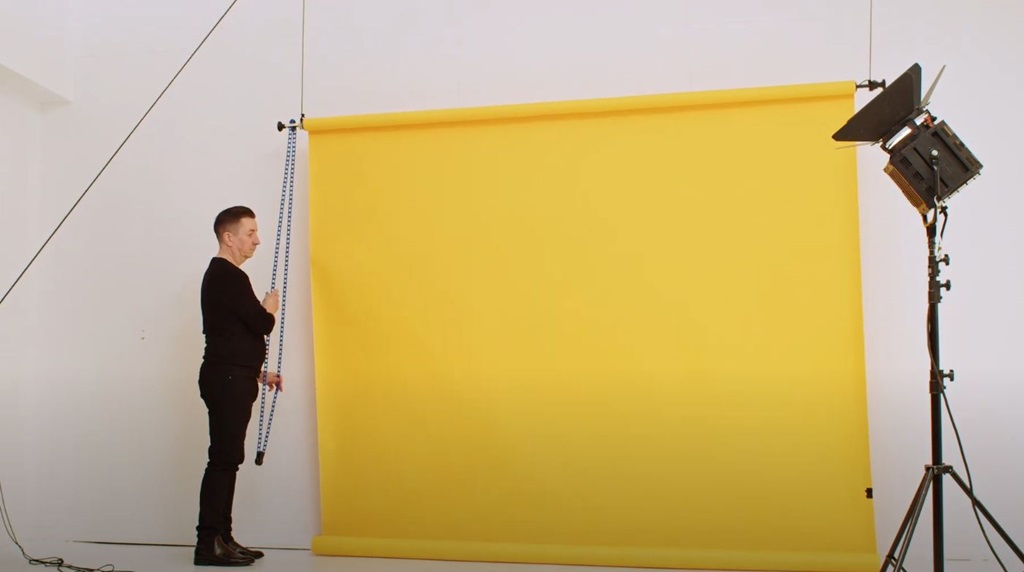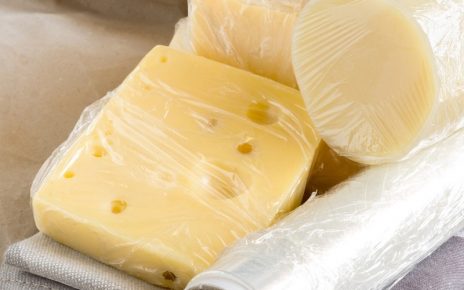Having the right photography backdrop can make all the difference in your photoshoots. But dealing with backdrops can be a hassle – they wrinkle easily, take up a lot of space, and are difficult to set up. That’s where a photography backdrop roller system comes in. These systems allow you to easily roll out wrinkle-free seamless backdrops in seconds.
What is a Photography Backdrop Roller System?
A photography backdrop roller system consists of a sturdy stand with a rod or tube on which your backdrop rolls. The backdrop attaches to the rod, allowing you to smoothly roll it down to the desired length. The stand keeps the backdrop taut and wrinkle-free. Some systems feature spring-loaded roller tubes while others use a manual crank to roll out the backdrop.
Backdrop roller systems come in a variety of sizes, materials, and configurations. But in general, here are the main components:
- Stand – This supports the roller rod and keeps the system upright. Stands can be collapsible for portability or fixed for maximum stability.
- Roller Rod – This horizontal rod holds the rolled backdrop material. It may be manually operated or spring-loaded.
- Backdrop Material – The actual backdrop that rolls onto the rod. Often made of paper, vinyl, or cloth.
- Feet – Stabilize the stand and allow adjustments to the height/angle.
- Crossbar & Backdrop Supports – A crossbar attaches to the stand to support the backdrop material at the bottom. Some systems use clamps while others have slots.
- Carrying Case – For portable systems, a sturdy case transports and protects the components.
Benefits of a Backdrop Roller System
Why use a photography backdrop roller system instead of just hanging backdrops or using a fixed stand? Here are some of the main benefits:
- Fast Setup – With a roller system, changing backdrops takes seconds. Just pull one down and roll down the next. No need to swap stands or refold backgrounds.
- Wrinkle-free – Rolled backdrops emerge smooth and wrinkle-free. The rod applies consistent tension for a pristine look.
- Space Saving – Rolled backdrops take up far less storage space than folding multiple backdrops.
- Versatile – Use different colored/patterned backdrops for various shots. Easily alternate between materials like paper, fabric, vinyl, and more.
- Adjustable Size- Roll out just what you need for the shot. Adjust to different heights and widths.
- Portable – Collapsible roller systems with carrying cases make transportation easy for location shoots.
- Durability – Quality backdrops stands endure heavy studio use, location shoots, and lots of rolls/unrolls.
- Professional Results – Get commercial quality, seamless backdrop photos quickly and consistently.
For photographers that work with different backdrops, roller systems are indispensable for their speed, consistency and adaptability.
Types of Backdrop Roller Systems
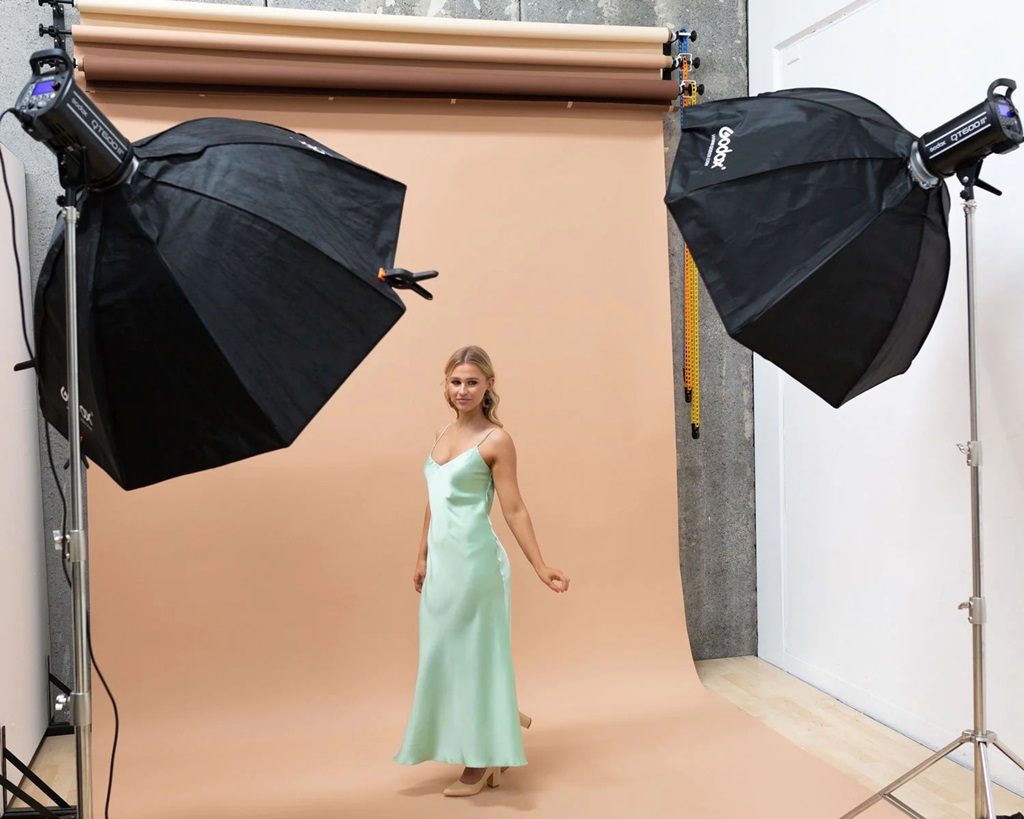
Not all photography backdrop roller systems are created equal. They come in a range of sizes, materials and configurations to suit different users’ needs. Here are the main types of roller systems:
Spring Roller Systems
Spring roller systems utilize an internal spring mechanism to automatically roll up the backdrop. Just pull down the amount needed and the spring will roll up any excess. This makes changing backgrounds faster and easier without cranking. It also applies consistent tension to keep backdrops taut. Easy set up and tear down make spring systems ideal for location work. Brands like Borns, Neewer, LimoStudio, and more offer spring roller systems.
Pros
- Fast, hands-free roller up
- Consistent tension
- Quick set up/breakdown
Cons
- Heavier than manual systems
- Springs may wear out over time
Manual Roller Systems
With manual roller systems, the user physically turns a handle to roll up the backdrop onto the rod. This gives precise control over the exact backdrop positioning. Manual systems have removable crank handles for easy storage. They are lighter than spring systems, making them better for travel. Leading brands include Fotodiox, Impact, and CowboyStudio.
Pros:
- Lightweight
- Precise backdrop control
- Removeable crank saves space
Cons:
- Needs cranking each time
- Inconsistent tension
Motorized Roller Systems
Motorized systems provide powered scrolling of backdrops with the push of a button or remote. The electric motor smoothly rolls the backdrop up and down on industrial tubing. This enables completely hands-free operation. Motorized systems are fastest for changing backgrounds and offer consistent tension. But they are also the most expensive and heaviest systems. Aurora and JTL are top motorized system brands.
Pros:
- Push button backdrop changes
- Fast & consistent rolling
- Hands-free operation
Cons:
- Most expensive
- Heavy
- Electrical power required
Collapsible Roller Systems
Collapsible backdrop roller systems have legs and a crossbar that fold up for easy transport and storage. This compact “suitcase” design with carrying case makes location photography hassle-free. Muslin, vinyl, and paper backdrops can all attach to the detachable support bar. When collapsed, the system is only about 3 feet long. MorfBoard, PBL, and Photoflex make popular collapsible roller systems.
Pros:
- Ultra portable
- Protective carrying case
- Fast location setup
Cons:
- Less stable than fixed stands
- Size limits backdrop width
Auto-locking Roller Systems
Auto-locking mechanisms on the roller rod hold the backdrop in place at the desired length. This prevents backdrops from unrolling or shifting during shoots. Photographers don’t have to keep tension on the backdrop by hand. For big, heavy backdrops, the auto-lock provides an important safety feature. Photek and Savage both offer backdrop systems with auto-locking rods.
Pros:
- Holds backdrop in place
- Allows hands-free operation
- Safer with large/heavy backdrops
Cons:
- More complex mechanism
Ceiling-Mounted Roller Systems
As the name suggests, ceiling-mounted systems attach directly to the ceiling rather than resting on the floor. The backdrop unrolls down the wall from above. This saves floor space and creates a seamless ground-to-ceiling backdrop. But installation is more complex. JTL and Boca both make ceiling-mounted roller systems.
Pros:
- Saves floor space
- Seamless ground-to-ceiling backdrop
Cons:
- Permanent ceiling installation
- Adjustments require ladder
Choosing the Right Photography Backdrop Roller System
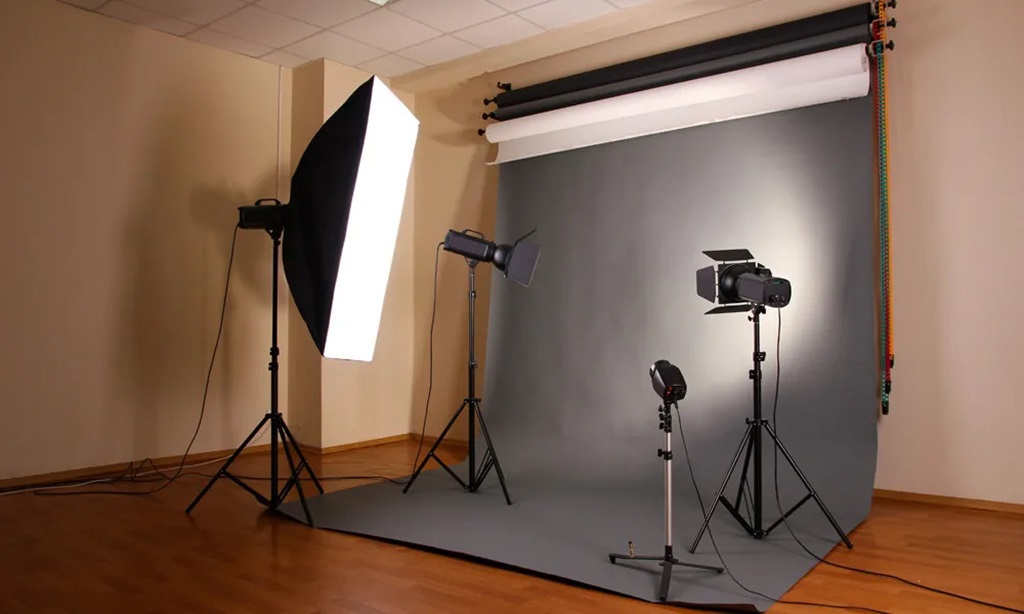
With so many backdrop roller systems on the market, it can be tricky to select the right one. Here are the key factors to consider for your needs:
Size
The backdrop width determines how much of your scene the backdrop will cover. Typical widths range from 5-16 feet but can be wider. Height is also important for full-length subjects. Consider your studio space dimensions and typical subject matter.
Backdrop Material
The fabric used for the backdrops affects appearance and durability. Muslin is a lightweight cotton/polyester blend that gives a soft focused look. Vinyl is thicker with a glossy finish. Paper backdrops are disposable. Choose material to suit your photo style.
Portability
If you shoot on location often, opt for a lightweight collapsible system that packs into a case. But if mainly in a fixed studio, a larger heavy-duty system offers greater stability.
Ease of Use
Manual systems offer more control over backdrop positioning. But spring or motorized systems are the fastest and easiest for repeatedly changing backgrounds. Go hands-free or get precise control?
Budget
Pricing ranges from $100 for simple manual units to $500+ for motorized systems. Identify how much you can invest to get the right features and quality.
Analyze your space, transport needs, budget, and shooting style to select the best photography backdrop roller system.
Top Brands of Backdrop Roller Systems
Numerous companies manufacture backdrop roller systems to meet varying photographic needs and budgets. Here are some of the top brands:
Borns Backdrop Roller System
Borns makes mid-range spring roller systems for easy expandable backdrops. Models like the Auto Roller 2 support up to a 14’ wide backdrop. Portable kits come with a bag and background stand. Borns uses good quality materials for smooth rolling and durability.
Key Features:
- Spring driven auto-rolling
- Steel supports and chrome plated steel tubing
- Portable kit options
Impact Backdrop Support System Kit
Impact offers very affordable and functional backdrop support systems in complete kits. The air-cushioned stand uses strong aluminum tubes with steel reinforced plastic leg fittings. It works with muslin, canvas, vinyl and paper backdrops up to 10’ wide.
Key Features:
- Complete kits under $150
- Air cushioned stand
- Fits 10’ wide backgrounds
Savage Matte White Background Support System
Savage is a top brand for photography gear including backdrops and support systems. Their matte white background roller system creates a classic continuous sweep of seamless white. It uses heavy-duty supports and auto-locking brakes for safety.
Key Features:
- Seamless sweep of matte white
- Auto-lock brakes
- Durable steel supports
Neewer Automatic Spring Backdrop System
Neewer makes affordable photography gear like softbox lighting kits and backdrops. Their spring backdrop roller system comes in 8’ and 10’ widths. The aluminum alloy rods and legs make it sturdy yet lightweight for location work.
Key Features:
- Budget spring driven system
- 8’ and 10’ width options
- Lightweight aluminum alloy construction
JTL Motorized Background Roller
JTL engineers premium motorized backdrop systems for busy studios. Their Background Roller has variable speed control and radio syncing. Heavy duty all-steel construction ensures years of regular use. It’s an investment for maximum efficiency.
Key Features:
- Powerful variable speed motor
- Radio synchronization
- Heavy-duty steel engineering
LimoStudio Auto-Locking Background Support
LimoStudio is another affordable brand that makes photography studio equipment. Their auto-locking background system uses a Chromakey green screen backdrop. The sturdy aluminum frame withstands heavy rolls of paper or fabric backdrops.
Key Features:
- Budget price under $150
- Auto-locking mechanism
- Comes with Chromakey green backdrop
These are just a few of the trusted brands that manufacture backdrop roller systems. There are many other companies producing quality options at different price points. Do some research to find the best fit for your studio or location needs.
Setting Up a Backdrop Roller System
Once you’ve selected the ideal photography backdrop roller system, it’s time to set it up. While every system will be slightly different, here is a general step-by-step guide:
Choose a Location
Pick an open space near an electrical outlet if using a motorized system. For portable systems, collapsed size and location surfaces (grass, concrete, etc.) will determine where you can set up.
Assemble the Stand
The stand legs often fold out into an inverted “U” shape. Lock them into place at the desired width. Place feet flats on the ground or fully upright to adjust height.
Mount the Crossbar
Attach the adjustable crossbar between the stand legs. This will support the bottom of the rolled backdrop. Position it at your desired backdrop drop length.
Insert the Roller Rod
Slide the backdrop roller rod through the holders at the top of the stand. For spring rods, pull down to click into locked position.
Attach Backdrop to Rod
Use clamps or tape to secure your backdrop material to the roller rod. Keep it taut but not stretched.
Roll Down Backdrop
Release any locks on the rod and unroll the backdrop down to the crossbar. For manual systems, gently crank the rod to roll it down.
Secure Bottom of Backdrop
Attach the bottom of the unrolled backdrop to the crossbar using the provided clamps or slots.
Fine Tune Position
Gently tug the backdrop from sides or bottom to remove any slight wrinkles or sags for a pristine look.
Safely Tear Down
When finished, carefully roll up backdrop prior to disassembling stand. Use care not to bend the roller rod.
Follow all safety guidelines provided with your specific backdrop roller system model. Now enjoy seamlessly changing out backgrounds for awesome shots!
Backdrop Roller System Accessories
While the stand, roller rod, and backdrop are the core components, you can further equip your photography backdrop roller system:
- Backdrop Kits – Purchase complete backdrop kits with a roller stand and multiple backgrounds. Options like solid color, green screen, cityscape, etc.
- Wheeled Base – For heavy systems, add a wheeled dolly to make moving the stand around easier.
- Backdrop Poles – Vertical telescoping poles reinforce very wide backdrops to prevent sagging in the middle.
- Remote Shutters – Allow remote shutter firing so photographers can be in front of the camera with subjects and change backgrounds.
- ** Saunders Paper Catch** – Attaches below the roller to catch discarded paper backdrop sheets.
- Backdrop Storage Rack – Safely store extra rolled backdrops overhead and swap them out as needed.
- Safety Cables – Provide an extra safeguard against heavy backgrounds unrolling. Attach to the roller rod.
- Spare Parts Kits – Handy to have replacement springs, clamp hooks, locking knobs, etc. in case pieces wear out.
Customize your photography backdrop roller system over time with useful accessories to maximize versatility.
Backdrop Roller System Tips
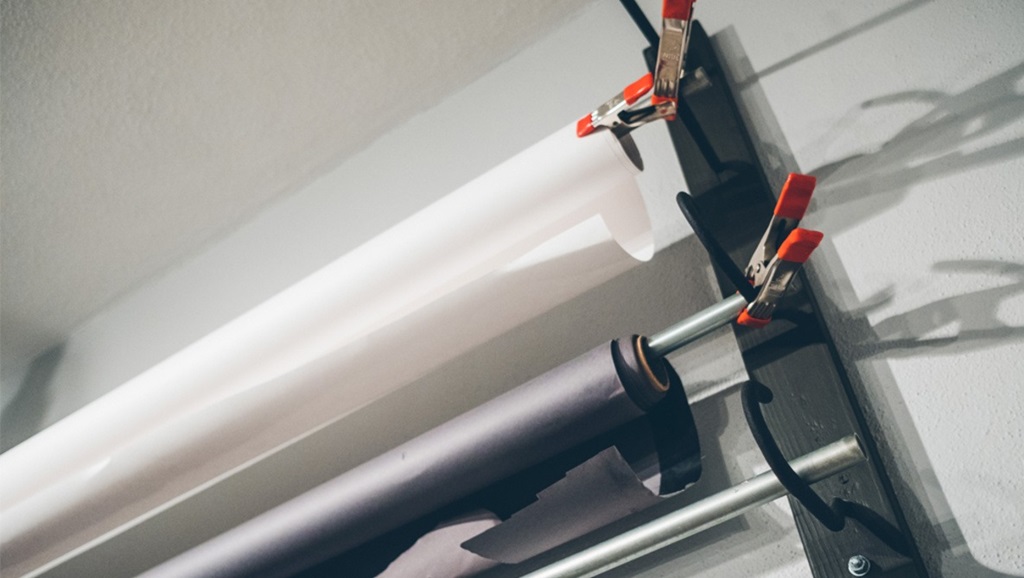
Here are some additional pro tips for getting the most out of your photography backdrop roller system:
- Keep backdrops attached to the roller rod even when not in use so they stay tight and wrinkle-free.
- Periodically check that bolts are tight and springs function properly for safety.
- Label backdrops attached to multiple roller rods to avoid mix ups.
- For paper rolls, use a razor to cleanly cut off used sections.
- Set up a backdrop storage rack to quickly swap different color/pattern options.
- Add a curtain rod and drapes to frame the edges of backdrops for colored borders.
- Use sandbags on the stand feet or a wheeled base for added stability outdoors.
- Carry spare backdrop attachment parts like clamps and loops when on location shoots.
Take the time to properly set up and maintain your photography backdrop roller system. Follow safety guidance and accessories can enhance functionality. With the right techniques, you’ll get professional-looking seamless backdrops to take your portraits to the next level.
Conclusion
Photography backdrop roller systems provide a fast, consistent way to seamlessly change backgrounds for professional results. Models like manual, spring, motorized, collapsible and more suit varied budgets and uses from studio to on-location. Consider your space, portability needs, and ease-of-use preferences when selecting a system. Quality brands like Borns, Impact, and Savage offer great options. Add accessories like backdrop storage racks for even more shooting flexibility. With proper use and care, a backdrop roller system can take your portrait photography to the next level.
FAQs
What size photography backdrop roller system should I get?
This depends on your available space, subject matter, and budget. Small home studios may only need a 5-7 foot system. Portrait studios often use 10 feet. Larger commercial spaces can utilize 16 feet or more. Wider systems allow you to stand farther back.
Are backdrops machine washable?
Backdrop fabrics like muslin and canvas can usually be machine washed on cold, gentle cycle. Avoid bleach. Air dry only as heat can cause shriveling. Some backgrounds like paper and vinyl cannot be washed – just wipe clean carefully.
How do I prevent backdrop wrinkles?
Using a roller system is the best way to keep backdrops taut and wrinkle-free. Attaching edges to the crossbar pulls the center smooth. For non-roller backdrops, clipping the top and pulling sides taut can minimize wrinkles.
Can I use a backdrop roller system outdoors?
Yes, portable collapsible systems with carrying cases are made for location photography. Be sure to weigh down the stand on any slick or uneven surface. Avoid overly windy conditions that can blow around backdrops.
What thickness backdrop material should I get?
Thinner, lightweight muslin or canvas is fine for most uses. Go for medium-weight if photographing fuller-figured subjects to minimize see-through. Heavyweight vinyls offer an ultra smooth, crease-resistant look.

